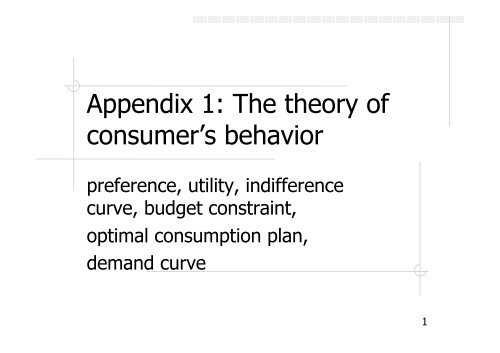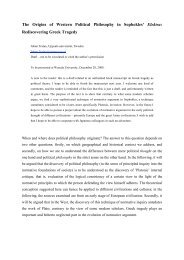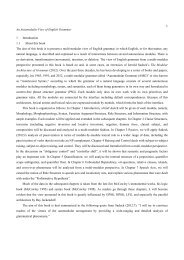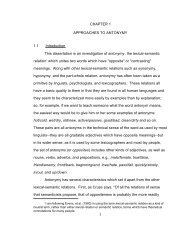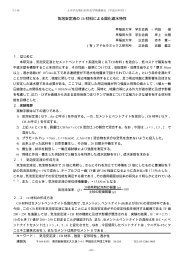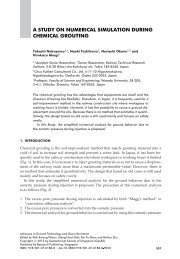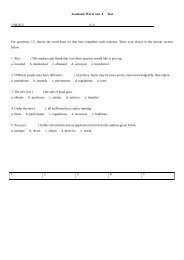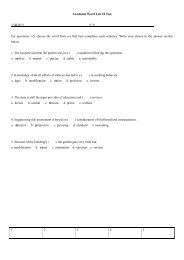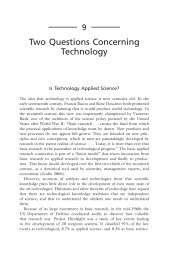Appendix 1: The theory of consumer's behavior
Appendix 1: The theory of consumer's behavior
Appendix 1: The theory of consumer's behavior
You also want an ePaper? Increase the reach of your titles
YUMPU automatically turns print PDFs into web optimized ePapers that Google loves.
<strong>Appendix</strong> 1: <strong>The</strong> <strong>theory</strong> <strong>of</strong><br />
consumer’s <strong>behavior</strong> <br />
preference, utility, indifference<br />
curve, budget constraint,<br />
optimal consumption plan,<br />
demand curve <br />
1
1. Preference ordering and<br />
utility function <br />
! Objects to be selected x, y, z<br />
! Consumption set consumption goods bundle<br />
x =(x 1 ,x 2 ,...,x n ) (Consumption vector)<br />
! Preference relation (binary relation)<br />
! Preference ordering<br />
! Value judgment about the alternatives<br />
! xRyx is strictly better than y or both are<br />
indifferent (x is at least as good as y)<br />
! xPyx is strictly better than y (prefer x to y)<br />
! xIyx and y are indifferent<br />
2
Nature <strong>of</strong> the preference<br />
relation <br />
! Reflectivity: xRx holds for any x.<br />
! Completeness:<br />
xRy or yRx holds for any x and y.<br />
! Transitivity: If xRy and yRz, then xRz<br />
holds for any x, y, and z.<br />
! Preference ordering = reflectivity +<br />
completeness + transitivity<br />
rational preference (relation) <br />
3
Utility function <br />
! Utility function preference ordering<br />
u=u(x),<br />
u=u(x 1 ,x 2 ,...,x n )<br />
! <strong>The</strong> function gives a large value to the<br />
desirable alternatives<br />
! Indifference curve utility function<br />
! <strong>The</strong> curve shows the group <strong>of</strong> alternatives<br />
to have the same desirableness <br />
4
y<br />
u=u(x 1 ,x 2 )<br />
x 2<br />
Indifference curve <br />
x 1<br />
5
x 2<br />
u 0
2. <strong>The</strong> budget constraint <br />
! Price (p 1 ,p 2 ,...,p n )>0<br />
! Income M>0<br />
! <strong>The</strong> quantity <strong>of</strong> purchase plan (<strong>The</strong><br />
quantity demanded) (x 1 ,x 2 ,...,x n )0<br />
! <strong>The</strong> budget constraint budget set<br />
! Expenditure Income<br />
! p 1 x 1 +p 2 x 2 +…+p n x n M<br />
! <strong>The</strong> budget line (budget constraint line)<br />
! p 1 x 1 +p 2 x 2 +…+p n x n =M<br />
7
<strong>The</strong> budget set <br />
! <strong>The</strong> budget set budget constraint<br />
! <strong>The</strong> set <strong>of</strong> the possible consumer goods<br />
bundles which satisfy a budget constraint<br />
(<strong>The</strong> opportunity set)<br />
! p 1 x 1 +p 2 x 2 +…+p n x n M<br />
! x 1 0, x 2 0,……,x n 0<br />
! <strong>The</strong> inside and the boundary <strong>of</strong> the triangle<br />
which was surrounded by the budget line,<br />
the vertical axis, the horizontal axis<br />
! <strong>The</strong> budget line : x 2 =-(p 1 /p 2 )x 1 +M/p 2<br />
8
x 2<br />
x 2 =-(p 1 /p 2 )x 1 +M/p 2<br />
M/p 2<br />
<strong>The</strong> budget set <br />
M/p 1<br />
0<br />
x 1<br />
9
M'/p 2<br />
M/p 2<br />
x 2<br />
<strong>The</strong> parallel shift <strong>of</strong><br />
the budget line<br />
M"
x 2<br />
<strong>The</strong> turn <strong>of</strong> the budget line p" 1
3. <strong>The</strong> optimal consumption plan <br />
! <strong>The</strong> indifference curve + budget constraint<br />
<strong>The</strong> optimal consumption plan (x 1 *,x 2 *)<br />
! <strong>The</strong> additional assumption about preference<br />
Monotonicity: <strong>The</strong> more, the better.<br />
Convexity (<strong>The</strong> law <strong>of</strong> diminishing<br />
marginal rate <strong>of</strong> substitution)<br />
<strong>The</strong> more, the better, and the less the worse.<br />
People like a mean better than the extremes. <br />
12
x 2<br />
marginal rate <strong>of</strong> substitution<br />
MRS=-dx 2 /dx 1 =u 1 /u 2 <br />
E<br />
dx 2 <br />
u=u 0<br />
0<br />
dx 1 <br />
x 1<br />
13
Explanation <strong>of</strong> MRS=u 1 /u 2 <br />
! Differentiate u=u(x 1 ,x 2 )<br />
du=u 1 dx 1 +u 2 dx 2<br />
! On the same indifference curvedu=0<br />
-dx 2 /dx 1 =u 1 /u 2<br />
! Since MRS=-dx 2 /dx 1<br />
MRS=u 1 /u 2 <br />
14
x 2<br />
A<br />
<strong>The</strong> law <strong>of</strong> diminishing marginal<br />
rate <strong>of</strong> substitution<br />
MRS A >MRS B >MRS C<br />
<strong>The</strong> indifference curve swelled<br />
up for the original point <br />
B<br />
0<br />
C<br />
u=u 0<br />
x 1<br />
13
! <strong>The</strong> optimal consumption plan (x 1 *,x 2 *)<br />
! Inner point C <strong>of</strong> the budget set not<br />
optimal<br />
Utility increases in moving to the boundary.<br />
! Point A on the boundary not optimal<br />
Utility increases in moving to the direction<br />
<strong>of</strong> point E on the budget line.<br />
! Point B on the boundary not optimal<br />
Utility increases in moving to the direction<br />
<strong>of</strong> point E on the budget line.<br />
! Point E is optimal<br />
the optimal consumption plan <br />
14
x 2<br />
To decide the optimal<br />
consumption plan <br />
A<br />
C<br />
E<br />
monotonicity:<br />
u 0
<strong>The</strong> optimal consumption plan <br />
! <strong>The</strong> budget line and the indefference<br />
curve touch.<br />
! price ratio<br />
= marginal rate <strong>of</strong> substitution<br />
p 1 /p 2 =MRS=u 1 /u 2<br />
! It satisfies the budget constraint<br />
with the equal sign.<br />
p 1 x 1 +x 2 p 2 =M<br />
16
4. <strong>The</strong> derivation <strong>of</strong> the<br />
demand curve <br />
! <strong>The</strong> optimal consumption plan<br />
change <strong>of</strong> the price<br />
! <strong>The</strong> new optimal consumption plan<br />
A wide range <strong>of</strong> prices<br />
! <strong>The</strong> demand curve x 1 =d 1 (p 1 ,p 2 ,M)<br />
! <strong>The</strong> curve (function) shows how the<br />
demand plan changes when the price <strong>of</strong><br />
the good is changed, making the prices<br />
<strong>of</strong> other goods and the income constant.<br />
19
x 2<br />
<strong>The</strong> derivation <strong>of</strong><br />
the demand curve <br />
<strong>The</strong> price-consumption<br />
curve <br />
E<br />
E 2<br />
0<br />
E 1<br />
M/p 1<br />
0<br />
M/p 1<br />
2<br />
u=u 2<br />
u=u 0<br />
u=u 1<br />
0<br />
x 1<br />
1<br />
x 1<br />
0<br />
x 1<br />
2<br />
M/p 1<br />
1<br />
20<br />
x 1
p 1<br />
<strong>The</strong> demand curve <strong>of</strong><br />
the 1st good <br />
p 1<br />
1<br />
p 1<br />
0<br />
x 1 =d 1 (p 1 ,p 2 ,M)<br />
p 1<br />
2<br />
x 1<br />
1<br />
x 1<br />
0<br />
x 1<br />
2 x 1<br />
21
5. <strong>The</strong> income effect and the<br />
substitution effect <br />
! <strong>The</strong> effect <strong>of</strong> income change<br />
<strong>The</strong> change <strong>of</strong> the quantity demanded<br />
when the income is changed<br />
<strong>The</strong> effect by the shift <strong>of</strong> the budget line <br />
22
M'/p 2<br />
x 2<br />
<strong>The</strong> normal good <br />
M/p 2<br />
<strong>The</strong> income-consumption<br />
curve <br />
M"/p 2<br />
M"/p 1 M/p 1<br />
M'/p 1 x 1<br />
23
<strong>The</strong> intermediate good <br />
<strong>The</strong> inferior property <br />
24
<strong>The</strong> effect <strong>of</strong> the price change <br />
! <strong>The</strong> change <strong>of</strong> the price<br />
i) <strong>The</strong> change <strong>of</strong> the real income (<strong>The</strong><br />
income effect)<br />
ii) <strong>The</strong> change <strong>of</strong> the relative price (<strong>The</strong><br />
substitution effect)<br />
! <strong>The</strong> compensation variation with<br />
income (<strong>The</strong> compensation income)<br />
How much income is needed after the price<br />
change in order to maintain utility level<br />
before the price change <br />
25
x 2<br />
x 2<br />
2<br />
x 2<br />
1<br />
x 2<br />
0<br />
E 1<br />
E 2<br />
E 0<br />
<strong>The</strong> income effect and<br />
the substitution effect <br />
u=u 1<br />
u=u 0<br />
0 x<br />
1<br />
1 x<br />
2<br />
1 x<br />
0<br />
1<br />
income effect substitution effect <br />
x 1<br />
26


